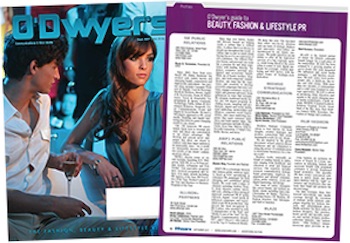|
|
Communicating and remaining relevant to both the Me Generation and Generation Me — not to mention everyone in between — has resulted in an evolution in the world of lifestyle PR. For the first time, communicators must prioritize audience and user journey above brand messaging, while taking into consideration the constant growth of influence in a typical consumer’s day-to-day.
Here are six ways lifestyle PR has changed. and the ride is just getting started:
Audience first
Historically, lifestyle PR led with a message the brand wanted to convey and one that was usually targeted to one very specific audience. Today, that audience is not only more diverse, but more influential in brand interactions.
|
|
Understanding the consumer journey and where/how they experience a particular brand is a critical piece of the evolution of lifestyle PR. Communications practitioners must use qualitative and quantitative data to understand their target audiences and all of the nuances that come with each group. Audience-first communications must communicate with consumers on the platforms that they choose, and speak to them in ways that they will best receive information, and not vice versa.
Roles are rolling
The days of writing and distributing press releases are over. Today’s news content is multimedia and includes video, interactive infographics, and is optimized for search. That means the role of the lifestyle PR practitioner is rolling along with the times. It has evolved from smiling and dialing reporters with a product announcement to integrated campaigns that extend the product lifecycle.
Today’s lifestyle PR practitioners are experiential events experts, digital thought leadership and social media savants and masters of content and storytelling across paid, owned and earned channels. What’s more, unlike any other point in history, the role of the lifestyle PR practitioner must take into account the political climate and what it means for brands. It’s fair to say that lifestyle PR practitioners have always been jacks of all trades, but today’s toolbox is bigger than ever.
The digital stakes getting higher
It’s now essential for any brand looking to connect with target consumers to understand and execute on channels outside of traditional PR. Both agencies and brands alike are looking to up their game in the digital sphere with specialists from data scientists to creative directors and from digital strategists to back-end programmers.
But, it’s not enough to just bring specialists onboard. Everyone working in lifestyle PR should have a digital mindset across all that they do, much like they do in their normal, everyday lives. To reach consumers, practitioners must communicate to them on the digital channels where they live, work and play.
The digital mindset is critical to creating campaigns and strategies that will drive brand awareness, loyalty and sales across the paid, owned and earned spectrum. Brands and agencies that don’t apply a digital mindset are destined to be left behind.
Influence in flux
Influence in lifestyle PR used to come from a few powerful names in the editorial world that could sink or save a brand with one article. Today, influence is more dynamic, more complex and very digital. Digital influencers now carry more sway than many traditional reporters. But the core of lifestyle PR is still all about relationships.
This new relationship is more focused on creating content alongside brands that is relevant, engaging and not necessarily brand forward. Influencers have taken the elusive WOM and made it a tangible reality across digital platforms. Influencers also offer up an opportunity for integration across paid, shared and earned media that can amplify brand voice and add impact to communications initiatives.
Generational whiplash
Just when we thought we might be getting a handle on Millennials, the spending power and brand influence of Gen Z is moving front and center. At the same time, brands cannot afford to ignore Gen X, Boomers and the Silent Generation. Multiple influential generations, different ways in which each wants to be communicated with, and the power of influence across the spectrum is giving communications professionals a bit of generational whiplash.
Lifestyle communications professionals must be able to create targeted messages that are flexible to shift as generations demand and work across all platforms.
Retail redo
Amazon’s purchase of Whole Foods is driving the retail world to face yet another redo in how we think about consumers and their interactions with brands. Whether online or offline, lifestyle brands must find a way to grab the shorter attention spans of consumers today, offer a seamless shopping experience, and capitalize on the proliferation of mobile.
It’s essential that an offline retail experience offer something different than what a consumer can find on Amazon, and it remains critical that an online experience do the same. All of this has implications for PR. Product cycles are shorter, consumer touchpoints are multiplying, and patience for both product and story is waning.
From approach, to the evolving marketplace, to how information is consumed, there are many things lifestyle PR practitioners must keep in mind when communicating today. The positive spin on all of this is that at its core, all of these changes can be both driven and managed by strategic storytelling. And that is what lifestyle PR has been since its inception. So, step up and enjoy the ride.
***
Maggie O’Neill is partner and managing director at Peppercomm.

 Maggie O’Neill
Maggie O’Neill

 Kim Kardashian West is using Full Picture PR for a $200M alliance with COTY Inc. to expand her KKW Beauty's product line and open new market categories.
Kim Kardashian West is using Full Picture PR for a $200M alliance with COTY Inc. to expand her KKW Beauty's product line and open new market categories. Fashion PR pro Kelly Cutrone has charged hip-hop mogul Russell Simmons with a rape attempt in 1991.
Fashion PR pro Kelly Cutrone has charged hip-hop mogul Russell Simmons with a rape attempt in 1991. Fashionable travel luggage and accessories are focusing on becoming more tech-centered to meet traveling and space-saving demands.
Fashionable travel luggage and accessories are focusing on becoming more tech-centered to meet traveling and space-saving demands. Celebrities have always played a key role in the marketing landscape. But companies eager to tap into social media channels are now making a conscious shift to include influencers in their online marketing plans, with the fashion and beauty industries leading the charge.
Celebrities have always played a key role in the marketing landscape. But companies eager to tap into social media channels are now making a conscious shift to include influencers in their online marketing plans, with the fashion and beauty industries leading the charge. It used to be standard for PR professionals to operate firmly behind the scenes. However, this invisibility can come at a cost to opportunities for thought leadership, discovery and an enhanced online presence that are metrics of success in our digital world.
It used to be standard for PR professionals to operate firmly behind the scenes. However, this invisibility can come at a cost to opportunities for thought leadership, discovery and an enhanced online presence that are metrics of success in our digital world.


 Have a comment? Send it to
Have a comment? Send it to 
No comments have been submitted for this story yet.